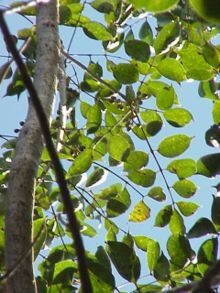Our website is made possible by displaying online advertisements to our visitors.
Please consider supporting us by disabling your ad blocker.
Burseraceae
| Burseraceae | |
|---|---|

| |
| Bursera simaruba (Gumbo-limbo) | |
| Scientific classification | |
| Kingdom: | Plantae |
| Clade: | Tracheophytes |
| Clade: | Angiosperms |
| Clade: | Eudicots |
| Clade: | Rosids |
| Order: | Sapindales |
| Family: | Burseraceae Kunth[1] |
| Genera | |
|
See text | |
The Burseraceae are a moderate-sized family of 17-19 genera and about 540 species of woody flowering plants. The actual numbers given in taxonomic sources differ according to taxonomic revision at the time of writing. The Burseraceae are also known as the torchwood family,[2] the frankincense and myrrh family, or simply the incense tree family. The family includes both trees and shrubs; its species are native to tropical regions of Africa, Asia, Australasia, and the Americas.
Because of taxonomic revision, as the family size (in terms of genera and species) differs according to the time period of study; so, too, does the family's higher-level relationships, including order. Burseraceae is a genetically-supported monophyletic group since APG III and is frequently cited within the Sapindales. It is recognized as a sister group to the Anacardiaceae.
The Burseraceae are characterized by the generally non-allergenic resin they produce in virtually all plant tissue and their distinctive smooth, yet flaking, aromatic bark.[3][4] The origins of the family can be traced to the Paleocene (about 65 Mya) when Beiselia mexicana first diverged in Mexico.[5] The subsequent divergences in the family lineage and migration of species in the Eocene (53 Mya) out of North America have led to the current distribution of the species being primarily associated with the tropics.[5] Though the family likely originated in North America, the greatest genetic diversity presently is found in the Southern Hemisphere.[5] Tabonuco (Dacryodes excelsa) and gumbo limbo (Bursera simaruba) represent the economic, ethnobotanical, and ecological significance of the Burseraceae in the Western Hemisphere, while frankincense (Boswellia sacra) and myrrh (Commiphora myrrha) represent the same in the Eastern Hemisphere.
- ^ Angiosperm Phylogeny Group (2009). "An update of the Angiosperm Phylogeny Group classification for the orders and families of flowering plants: APG III". Botanical Journal of the Linnean Society. 161 (2): 105–121. doi:10.1111/j.1095-8339.2009.00996.x. hdl:10654/18083.
- ^ Dimmitt, Mark A. "Burseraceae (torchwood family)". Arizona-Sonora Desert Museum. Arizona-Sonora Desert Museum. Retrieved 13 March 2016.
- ^ Judd, W.S., Campbell, C.S., Kellogg, E.A., Stevens, P.F., and M.J. Donoghue. 2008. Plant Systematics: A Phylogenetic Approach 3rd ed. Sinauer Associates, Inc., Sunderland, Massachusetts, USA.
- ^ Stevens, P. F. (2001 onwards). Angiosperm Phylogeny Website. Version 8, June 2007 [and more or less continuously updated since] http://www.mobot.org/MOBOT/research/APweb/
- ^ a b c Weeks, A., Daly, D.C. and B.B. Simpson. 2005. The phylogenetic history and biogeography of the frankincense and myrrh family (Burseraceae) based on nuclear and chloroplast sequence data. Molecular Phylogenetics and Evolution, 35: 85–101.
Previous Page Next Page


